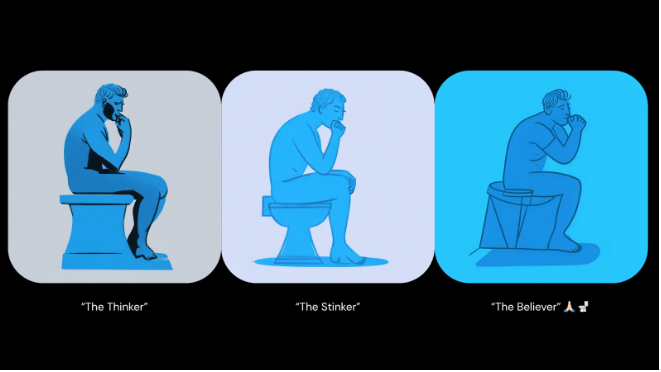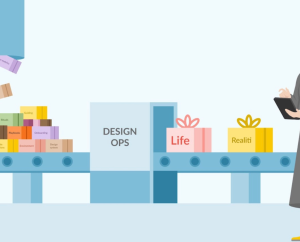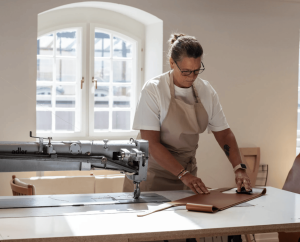Mick Champayne is a Chicago-based designer by day and an illustrator by night. In a nutshell, she loves internet culture, navel-gazing about the future, and imagining how designers can support people’s values and intentions. Currently a Senior Visual Designer at Google, she likes to create solutions that have beauty AND brains: making things look beautiful with smart strategy and a thoughtful user experience. From light-hearted memes to serious social commentary, she’s happiest when her work can spark a conversation.
Casey Hudetz is a designer, speaker, teacher and award-winning filmmaker living in Chicago. Since receiving his master’s degree in Human-Computer Interaction he has been designing digital products and services with a focus on emerging technologies (such as AI, AR, and Voice). Over the last decade, he has given talks around the world about artificial intelligence, speculative design, art history and more. He currently leads the AI and design team for DocuSign. In his spare time, you can find him biking around the city with his wife and two sons.
1. What design trends do you think will take off this year and more in the future?

Mick: Well, it’d be too easy to say “AI”, wouldn’t it? But more specifically I’ve been thinking a lot about generative AI in the context of collaboration and connection. Firstly, I think we’re just at the beginning of understanding how we can use AI as a creative collaborator. For example, I’ve been training my own model on my illustration style, and while I’m “happy” with maybe 1 out of 20 or 30 images it makes (with low expectations!), I’m more excited about how it’s helping extend my imagination. It’s like a great improv partner who takes your little brainfart prompt, says “yes, and…”, then builds on that idea.
In terms of connection, I think genAI will also play an important role in how we share in a way that is much more authentic. Social platforms feel very individual and transactional right now: taking photos, sharing videos, getting likes. But I think genAI has the unique opportunity to turn these platforms into truly collective social experiences. We’re already starting to see this in features like Spotify Blends that you make with friends (smart playlists that combine your musical tastes) or Pinterest’s Shuffles which lets you create and share interactive collages. I think it will be very fun to see how genAI can help not only empower people’s creative expression but make the way we connect with each other more meaningful and human.
Casey: I believe AI will transform not only the products and features we’re designing but also the way we design. It is less of a trend and more of an inflection point for our industry.
In the same way that the mobile revolution brought about the (exciting!) process of developing new patterns of interaction for the smartphone experience, the AI revolution will require the design community to develop new norms and patterns that align with users’ mental models and the new experiences AI will enable.
In addition, I believe the process of designing itself will be transformed. As more intelligence is infused into the products we use every day (Miro, Figma, Adobe Suite, Google Sli<des, etc), we will have access to a collaborative teammate that will help us generate ideas, make decisions and improve user outcomes. New ways of working will develop and the design teams that can harness all of these new tools will be better positioned to focus on their craft and less on the mundane details.
Or we will be overwhelmed by it all and will commiserate with fellow designers by sharing dumb memes.

2. When it comes to making design and the design industry more diverse, equal, and inclusive, what changes are needed or would you like to see?
Mick: The design industry can be a very cliquish and exclusive place, and a design education can have a pretty high cost for entry. I hope that AI acts more as a great equalizer when it comes to making design more accessible. An optimistic scenario would have AI-powered tools leveling the playing field by making design education more affordable and available to everyone, enabling people from diverse backgrounds an opportunity to visualize their ideas and perspectives.
But it’s a two-pronged approach, right? As design practitioners, at the heart of what we do is solve problems for people, continually building our empathy muscles. So it’s still the responsibility of those in leadership to actively advocate for and nurture a diverse and inclusive culture by promoting visibility and being intentional with hiring practices.
Casey: I’m going to +1 all of Mick’s points and add that pursuing diversity and inclusivity within the design industry is not only morally justified, but also good for end users. Having a diverse team can significantly “open the aperture” for design teams and enhance problem-solving capabilities both from a user empathy POV and ideation process. This diversity of backgrounds and expertise opens up new possibilities, allowing teams to explore innovative solutions and tackle challenges more effectively.
3. What are the biggest challenges you’ve had to face as a designer? Did you overcome them? How?
Mick: I used to think there was a right way to “Design”—and I was doing it the wrong way. There are so many great designers and creatives out there, and it’s so hard not to get swept up in feelings of imposter syndrome and the pressure to be perfect! I wish I had an antidote for that, but maybe it’s just the creative person’s eternal plight? Either way, it’s taken me a long time to learn that there’s no one way to design. How boring would it be if everybody thought the same thoughts or made the same things?
But it’s all about the journey, not the destination, man. What I’ve found that helps is 1) remembering we’re ALL feeling that way, and 2) forgetting any preconceived notions of what “design” should be, and embracing your own weirdness. When you design from that place, it naturally makes your work more interesting and engaging, which will resonate with more people. It’s like the law of attraction. For example, I love to draw a lot of butts and farts. Weirdly the more I put those things out there, the more people want more of it, and I’ve picked up a lot of fun projects and met a lot of cool people because of it!
Casey: I believe the design field attracts individuals who possess a heightened sense of sensitivity, and I certainly fall into that category. In the early stages of my career, this sensitivity led me to prioritize seeking consensus and alignment on my design decisions from my colleagues, as I wanted everyone to feel satisfied and comfortable moving forward. However, I was never truly satisfied with my work, feeling as if I compromised too often.
As time went on, I realized my primary responsibility as a designer is not merely to please my cross-functional partners, but rather to passionately advocate for the needs of the users. Looking back, this seems like an obvious insight, but when I was initially building my career, I felt that being kind and agreeable was the best way to fit in. I admit that I still occasionally experience discomfort with conflict and don’t voice my concerns loudly enough. But at least now I understand that building a truly user-centric product requires more than going along with what is convenient and easy to ship.
4. What are 3 things you were not taught in school (if you were formally trained in design) that you wished you had been taught?

Casey: When I started my career I noticed that the most successful designers possessed business acumen, adeptness in facilitating meaningful conversations, and the ability to present their ideas with clarity and confidence. I was lacking in all of those areas.
I often found myself grappling with questions such as: How do my design decisions effectively align with the needs and goals of both the users and the business? How can I facilitate knowledge-sharing, ideation, and consensus-building within a group in a structured way? Additionally, how can I ensure that my work is comprehensible and resonates with its intended audience?
While I have made some progress over time, I realize those skills couldn’t be fully mastered through my HCI program alone. While my program provided a foundation, I believe that these skills are best honed through experiential learning, which involves taking risks, learning from failures, and continuously improving.
Mick: I’d like to +1 all of Casey’s answers, and add that I think the common thread here is all about being able to communicate your ideas. With this explosion of AI and anyone (and anything) can design, what will set you apart will be your point of view: your expertise, good taste, and creativity. Being able to articulate your thoughts, socialize your work, and have productive collaboration will become invaluable.
5. Why do you think design matters?
Casey: Design matters because it shapes our world in profound ways. A thoughtfully designed city fosters active lifestyles and inclusivity through vibrant public spaces and accessible infrastructure. A well-crafted digital experience can empower individuals to make the most of their time and lead productive lives. A cozy room that embraces the Danish concept of “hygge,” wraps its inhabitants in a comforting atmosphere and improves their home life. Design has the potential to enhance our well-being, happiness, and sense of belonging. It is a force that can transform both big and small aspects of our lives.
Design matters not only for its positive impact but also because of the potential harm it can cause. Poorly designed cities can perpetuate inequality, with inaccessible infrastructure and limited green spaces that negatively affect their inhabitants. Similarly, a badly designed digital experience can lead to information overload, addiction, and loss of privacy, compromising users’ mental and emotional well-being. A cluttered and disorganized room can create a chaotic and stressful environment, hindering relaxation and productivity. Design, when not carefully considered, can diminish the quality of our lives.
By recognizing the influence of design, we can strive for a future where design consistently enhances the lives of individuals and communities alike.
Mick: I once heard someone say on RuPaul’s Drag Race, “I’m here for a good time, not a long time,” and it really stuck with me. I believe that the purpose of life is happiness, and ultimately the reason we do anything. And so when it comes to design, when it’s done well, it can have a profound positive impact on our lives, making us feel happier and more connected. Good design resonates because we are emotional beings, and it is this potential for emotional engagement that gives design its true value. As designers, we have the ability to transform normal, “boring” things into exceptional ones with thought and intentionality. (That’s also what I think will always separate us from the robots—but that’s a tangent for another time!) It’s about creating experiences that are meaningful and memorable. It’s about making people feel better about themselves and the world around them.
* * *
Mick / Casey will give a talk at the digital design conference Design Matters 23, which will take place in Copenhagen & Online, on Sep 27-28, 2023. Their talk “Text-to-________. What Generative AI Means for Designers”, will explore how we can use the power of this new technology to improve design processes, generate new ideas and build inclusive digital experiences for all. Get your ticket here! And if you want to connect with them, find Mick on LinkedIn or visit her website, and connect with Casey on LinkedIn or check his website too.



